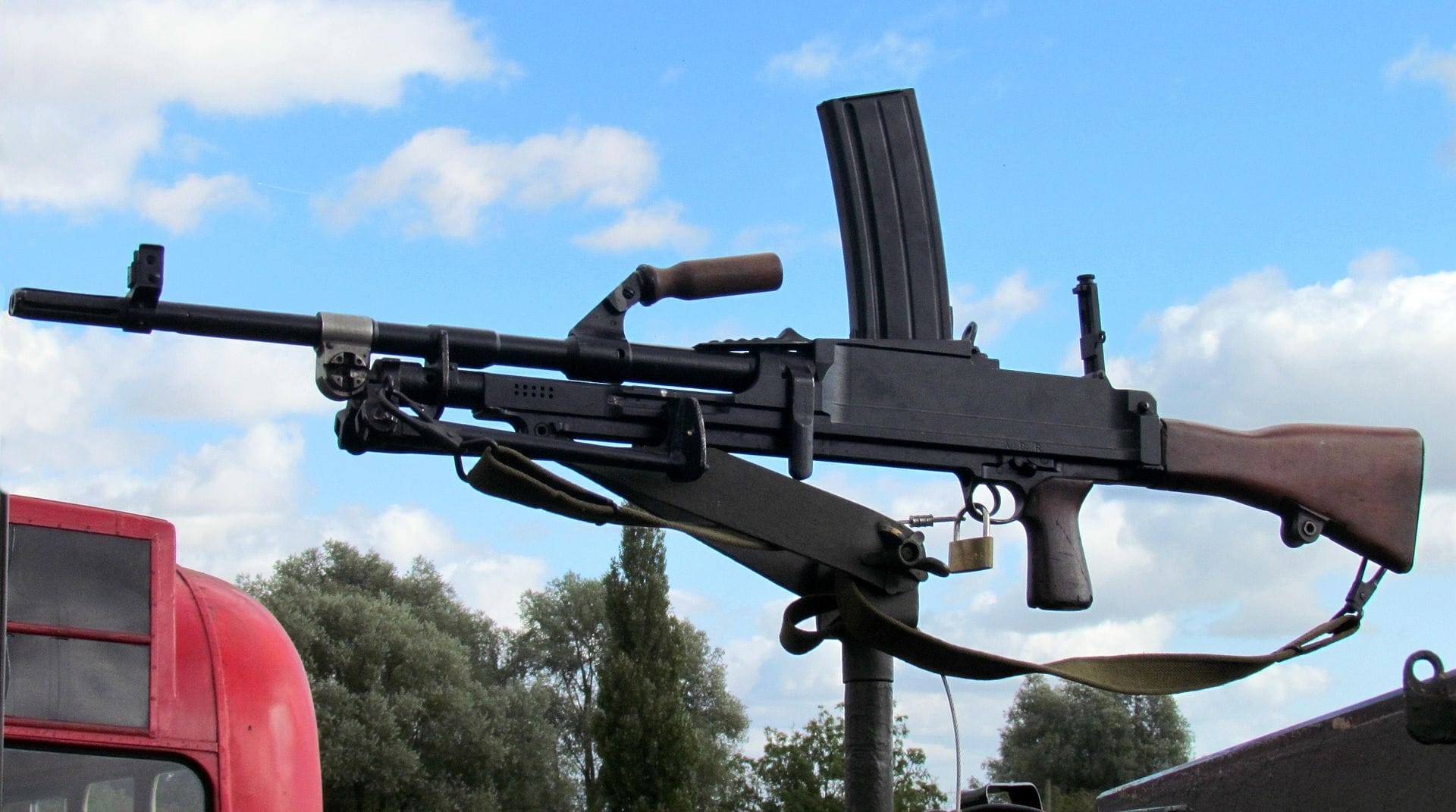A few weeks back, in my writeup on the world’s worst 10mm handguns, one of the pistols I mentioned was the Bren Ten, which I noted was “named for Brno, the center of the Czech gun industry, not the British Bren light machine gun.” That inspired me to write about the British weapon. So without further ado, let’s discuss that Bren gun.
Bren Gun Early History and Specifications
The Bren light machine gun (LMG) was designed and approved for British Army service in 1935, and began production in 1937. It was selected by the British Army’s Small Arms Committee as a replacement for the Lewis light machine gun of the First World War, which by some accounts had a reputation for jamming.
Going back to Brno, it turns out that the city was an inspiration for the LMG as well. Weapons history expert Leroy Thompson – whom I have cited in several previous 19FortyFive articles, especially for his excellent book The Rescuers: The World’s Top Anti-Terrorist Units — elaborates in an October 2014 article for Athlon Outdoors:
“[I]t was the Czech ZB vz. 26 light machine gun that was eventually modified to suit British needs and licensed for production…The Bren took its name from a combination of the first two letters of Brno, the Czech city where the original version had been developed, and Enfield, the location of the Royal Small Arms Factory. It uses a long-stroke gas piston system located under the barrel. A return spring is located in the butt. Additionally, the Bren is air-cooled, select-fire and has a quick-detachable barrel; normally two barrels were supplied with each Bren to allow a change if one got hot from continuous firing. Magazines feed into the top of the Bren, which necessitates sights that are slightly offset.”
The gun was initially chambered for the .303 British round, thus enabling cartridge commonality with the Lee-Enfield SMLE infantry rifle. However, during the Cold War, it was reconfigured for the 7.62x51mm NATO round.
Specifications included a barrel length of 25 inches, an overall length of 45.5 inches, and a fully loaded weight of 25 pounds. Cyclic rate of fire was 520 rounds per minute, with a sustained rate of 120 rpm. Effective firing range was 600 yards, and max firing range was 1,850 yards.
Real-World Combat Performance
The title — “The Bren Light Machine Gun: Legendary Reliability” — and opening paragraph of an article on the Colour Sergeant Tombstone’s History Pages website sums up the gun’s performance:
“One of the most important and iconic weapons of World War II was the British Bren light machine gun. The Bren’s distinctive top-mounted curved magazine made it easy to recognize by friend and foe alike. Troops throughout the British Empire praised the Bren for its reliability.”
Given the timing of the weapon’s design and adoption, it should surprise nobody that it was during the Second World War that the Bren first established its reputation for legendary reliability. Nothing I can type here within the confines of an essay limited to 1,000 words can do it justice.
Regarding the gun’s use in conflicts beyond WWII, it appeared in a veritable laundry list of “hot wars” that took place during the Cold War, from the Korean War to the Malayan Emergency to the Mau-Mau Uprising to the Falklands War. It saw combat for the last time during the 1991 Gulf War. For those of you fellow history buffs who have the 1985 book War In Peace: Conventional and Guerrilla Warfare Since 1985, the Bren gun features prominently in the sections of the Greek Civil War of 1945-1949 and the Korean War.
The Bren LMG remained in production until 1971, with roughly 500,000 produced. Aye, definitely a more successful track record than the Bren Ten pistol.
Where Are They Now?
A non-firing Bren Gun was recently sold on the GunsAmerica.Com website for $1,200, and UK company GunStar has two deactivated specimens for sale, at £1,200 and £1,500 (equivalent to $1,549.16 USD and $1,936.44 USD as I type these words).
For those of you blokes who don’t feel a need to pay the proverbial arm & a leg to actually own a deactivated Bren Gun and are content to view them in a museum, among your options are the Norfolk Tank Museum and the Royal Museums Greenwich in the UK. Military history buffs living or those visiting Down Under can see one at the Australian War Memorial in Campbell, Australian Capital Territory.
Christian D. Orr is a Senior Defense Editor for 19FortyFive. He has 34 years of shooting experience, starting at the tender age of 14. His marksmanship accomplishments include: the Air Force Small Arms Ribbon w/one device (for M16A2 rifle and M9 pistol); Pistol Expert Ratings from U.S. Customs & Border Protection (CBP), Immigration & Customs Enforcement (ICE), and the Federal Law Enforcement Training Center (FLETC) Criminal Investigator Training Program (CITP); multiple medals and trophies via the Glock Sport Shooting Foundation (GSSF) and the Nevada Police & Fires Games (NPAF). Chris has been an NRA Certified Basic Pistol Instructor since 2011.
From 19FortyFive

